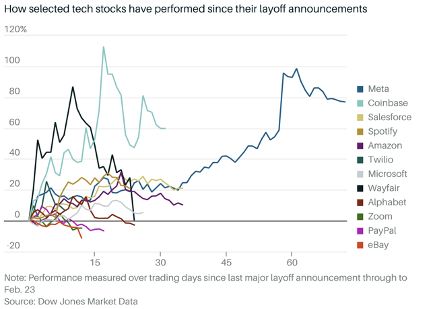What’s happening?
Layoffs are currently happening in various industries, but some of the hardest-hit sectors include tech, retail, real estate, and logistics. Numerous well-known businesses such as Google, Meta, Microsoft, and Amazon have laid off workers, and they represent the full spectrum of the tech industry, including social media, streaming, e-commerce, and artificial intelligence. It’s crucial to remember that not all industries are experiencing layoffs. Healthcare and education are two fields that are still hiring. Although there is an overall trend towards layoffs, more industries, such as retail and logistics, are expected to be impacted in the coming months. The tech industry increased its layoffs by 649% in 2022. More than 1,040 people were laid off from US-based tech companies in the last week of June 2023. As of July 6, 2023, more than 151,054 workers in US-based tech companies were laid off; in 2022, more than 93,000 jobs were slashed from public and private tech companies in the US.
Who’s Involved?
Legend :
| Stakeholder | How much power/ influence do they have? | How much INTEREST do they have? | What are their MOTIVES / OBJECTIVES? | Ongoing and/or Recent Actions |
|---|---|---|---|---|
| Meta | 5 | 3 | Improve revenue and handle cost-cutting by investing in projects that bring profits Adapt to changing market conditions and focus on proven new technologies, most commonly in AI | Meta announced 10,000 layoffs on May 16, 2023. In April 2023, Meta CEO Mark Zuckerberg announced slow hiring for the rest of the year, focusing on more critical areas such as social media platforms. Announced on June 7, 2023, launching a Community Forum aimed at gathering feedback from people on the principles they want reflected in Generative AI. |
| Amazon | 5 | 3 | Laid off over 9,000 employees in April 2023, focusing on retail and corporate divisions. In April 2023, Amazon CEO Andy Jassy announced Amazon’s focus on more critical areas, such as its fulfillment and logistics networks. | |
| Alphabet (Google) | 5 | 3 | Laid off about 12,000 workers as of March 2023, or around 6% of its workforce. In April 2023, Alphabet CEO Sundar Pichai said the company would focus on its search and advertising operations. | |
| Investors | 4 | 4 | Protect and maximize investment returns Mitigating financial risks and volatility | The stock prices of tech companies are still below their pre-pandemic levels. If investor sentiment shifts negatively, stock prices will decline. |
| US Government | 3 | 3 | Maintain economic stability and growth Reduce unemployment rates | On April 19, 2023, President Biden met with CEOs from tech companies and discussed his American Jobs Plan, taking steps to address working with businesses to improve tech and traditional supply chains. Senator Elizabeth Warren proposed the Layoff Prevention Fund Act to create a $100 billion fund. Representative Alexandria Ocasio-Cortez has called for the government to develop a Job Guarantee program. Representative Ro Khanna has called for the government to invest in infrastructure and clean energy. Republicans have proposed investing in workforce development programs like Job Corps to provide free education and training to young adults ages 16 to 24. Workforce Innovation and Opportunity Act (WIOA) provides funding for workforce development programs at the state and local levels. The law provides funding for a variety of programs, including training, apprenticeships, and job placement services. |
| Employees | 1 | 5 | Job security and stability Career development | In January 2023, Google employees filed a class-action lawsuit, alleging that the company’s layoff practices violated California’s labor laws. In November 2022, Twitter employees filed a class-action lawsuit accusing Twitter of laying them off in violation of California’s layoff notification law. |
With 1 being low and 5 being high
Power/influence is characterized by the amount of control and interest, as defined in terms of the impact or effect they have on the current situation, i.e., the influence or control these parties have on the layoffs.
Investors include venture capitalists, private equity firms, and public equity investors
What are the Likely Responses?
Layoffs are now frequently portrayed as a sign of effective leadership and even rewarded with a temporary increase in an organization’s stock price. It indicates that a CEO is willing to make tough decisions to improve a company’s bottom line. Investors frequently see layoffs as an indication that a business is improving its productivity and profitability, which drives up the stock price, while employees may see them as a sign of job insecurity and a lack of commitment from the company. An article from the Harvard Business Review mentions that layoffs can raise questions for investors. The article states that investors may question whether layoffs are a sign of deeper problems at the company or whether they are simply a short-term measure to improve profitability. The article also states that layoffs can damage a company’s reputation and make it more difficult to attract and retain top talent.
However, employees tend to see that the long-term effects are often negative, as a company’s ability to recruit and keep top talent may be hampered. Ultimately, the decision of whether or not to lay off employees is a complex one that should be made on a case-by-case basis by the companies.
Restructuring can take many forms, from layoffs to a focus on new products or services. The success of a restructuring effort will depend on the specific type of restructuring that is implemented and the factors that led to the need for restructuring in the first place. Some economists believe that a company’s restructuring process often begins with layoffs. Once the company has a strong foundation, it can focus on growth again. The stock price will likely increase as a result of this development, which involves making investments in new products or services, expanding into new markets, or acquiring other businesses. The success of a company’s restructuring effort cannot be guaranteed just by restructuring, but it has a decent chance if it is well-managed and offers quality products or services. A study by the Society for Human Resource Management (SHRM) that surveyed over 2,000 HR professionals from companies of all sizes found that companies that were transparent about their restructuring plans were more likely to have employees who were understanding and supportive of the changes. Additionally, companies that offered severance packages to laid-off employees were more likely to have satisfied employees with the restructuring process. The study’s findings suggest that transparency and severance packages can help mitigate the negative effects of layoffs on employees and on the company as a whole.
Despite massive layoffs, the US labor market added 236,000 jobs in March 2023, while the unemployment rate dropped to 3.5% from 3.6% in February, according to Labor Department data. Although the increase in total employment is the smallest since December 2020, the labor market has been slowing down. In the first quarter of 2023, the economy only added 195,000 jobs, which was the slowest pace of job growth since the start of the pandemic. The labor markets have held up reasonably well, and while the inflation rate in the US has slowed down from its peak in May 2022, it is still higher than the inflation rate in Europe. In June 2022, the inflation rate in the US was 8.6%, while the inflation rate in the Eurozone was 8.1%.
Amid the uncertainty and as the economic environment changes, investors should be cautious and rely on assets that are likely to do well with rising interest rates. They should also re-examine their portfolios to ensure that they are still aligned with their risk tolerance and investment goals. Employees who have been laid off can utilize this chance to retrain or upgrade their skills by taking online courses, attending workshops, or attending seminars.

Resources :
- Companies’ Layoff Strategies A First Step? Four Questions For Investors
- Do Layoffs Pay Off? Meta, Amazon, Other Tech Stocks Paint a Mixed Picture
- A difficult decision to set us up for the future
- Update from CEO Andy Jassy on Amazon’s operating plan and additional role eliminations
- Bringing People Together to Inform Decision-Making on Generative AI
- Tech sector layoffs explained: What you need to know


